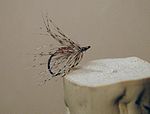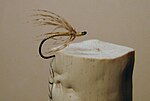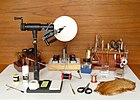| Partridge and Orange | |
|---|---|
| Artificial fly | |
 | |
| Type | Wet fly, soft hackle |
| Imitates | Emerging caddis or mayfly |
| History | |
| Creator | Unknown, described by T.E. Pritt (1895) |
| Created | 19th century |
| Other names | Spiders |
| Materials | |
| Typical sizes | 12–18 |
| Typical hooks | TMC 206BL, Daiichi 1130, Mustad C49S |
| Thread | Persall's Gossamer Silk, 6/0–8/0 nylon, Orange |
| Tail | None |
| Body | Thread |
| Ribbing | Fine gold wire (optional) |
| Hackle | English or Hungarian partridge neck |
| Thorax | Tan rabbit fur |
| Uses | |
| Primary use | Trout, grayling |
| Other uses | Panfish |
| Reference(s) | |
| Pattern references | Trout Flies-The Tier's Reference (1999), Hughes |
The Partridge and Orange is an artificial fly commonly categorized as a wet fly or soft hackle and is fished under the water surface. The fly is a very well known fly with its roots set firmly in English angling history. It is an impressionistic pattern fished successfully during caddis hatches and spinner falls. The Partridge and Orange is traditionally a trout and grayling pattern but may be used for other aquatic insect feeding species.
Origin

Soft-hackled flies as they are known today and in particular The Partridge and Orange originated in the north country of England and were first described by Joseph Wells in his 1842 publication THE CONTEMPLATIVE ANGLER. Later, T. E. Pritt's Yorkshire Trout Flies (1895) publication built upon Wells' earlier work and contained many of Wells' listed patterns, and were probably from the same source.
No. 32. ORANGE PARTRIDGE. Hook 1. WINGS. Hackled as in No. 31. BODY. Orange silk. These are practically the same flies, and are very excellent killers. I prefer the dressing of No. 32 myself, although one will kill as well as the other, and the angler may look upon one of them as indispensable on his cast from April to September, on warm days. It is the Turkey Brown of Ronalds, and the Spiral Brown Drake of Theakston.
Sylvester Nemes in The Soft-hackled Fly popularized this style of artificial fly in the early 1980s while giving credit to Pritt and many others for the evolution of this genera of pattern which had also been known as spiders.
Imitates
The Partridge and Orange resembles emerging caddis pupa, diving adult caddis or sunken may fly spinners
Pattern
- Hook: 12 – 18 medium/light wet fly or caddis pupa
- Thread: Orange 6/0 or 8/0
- Body: Formed with tying thread
- Rib: Fine gold wire (optional)
- Hackle: Mottled brown partridge
Variations and sizes
The Partridge and Orange is typically tied on standard wet fly and nymph hooks unweighted but may be tied on short caddis pupa hooks. Some tiers tie a bead head version. The gold ribbing may be omitted or replaced with a thread ribbing. There are similar versions of this fly known as the Partridge and Yellow and the Partridge and Green. Many tiers include a small section of fur dubbing for a thorax. Soft-hackle nymphs based on the Partridge and Orange design are tied with a wide variety of quill, feather and dubbed bodies.
Gallery
Images of soft-hackle nymphs-
Brown trout with soft-hackle fly
-
 Typical partridge feather used for soft-hackle flies
Typical partridge feather used for soft-hackle flies
-
 Partridge and Olive, Olive Goose Quill fiber body
Partridge and Olive, Olive Goose Quill fiber body
-
 Partridge and Pheasant, Pheasant Tail fiber body
Partridge and Pheasant, Pheasant Tail fiber body
-
 Partridge and Yellow, Yellow silk body
Partridge and Yellow, Yellow silk body
-
 Starling and Purple, Purple silk body, Starling hackle
Starling and Purple, Purple silk body, Starling hackle
References
- ^ Hughes, Dave (1999). Trout Flies–The Tier's Reference. Mechanicsburg, PA: Stackpole Books. p. 123. ISBN 978-0-8117-1601-7.
- Pritt, Thomas E. (1895). Yorkshire Trout Flies. Leeds, UK: Goodall and Suddick. p. 32.
- Schwiebert, Ernest (1973). Nymphs-A Complete Guide to Naturals and Imitations. New York: Winchester Press. p. 97. ISBN 0-87691-074-6.
Further reading
- Nemes, Sylvester (1975). The Soft-Hackled Fly. Greenwich, CT: Chatham Press. ISBN 0-8117-1670-8.
- Hughes, Dave (1995). Wet Flies: Tying and Fishing Soft-Hackles, Winged and Wingless Wets, and Fuzzy Nymphs. Mechanicsburg, Pa.: Stackpole Books. ISBN 0-8117-1868-9.
- Nemes, Sylvester (2004). Two centuries of soft-hackled flies–A survey of literature complete with original patterns. Mechanicsburg, Pa.: Stackpole Books. ISBN 0-8117-0048-8.
- Smith, Robert L (2015). The North Country Fly: Yorkshire's Soft Hackle Tradition. Machynlleth, Powys. Coch-y-Bonddu Books. ISBN 9781904784654.
External links
- Partridge and Orange at FlyAnglersOnline
- Tying the Partridge and Orange
- The Lost Flies of The Yorkshire Dales
- Seven Magnificent North Country Spiders
| Fisheries and fishing topic areas | ||
|---|---|---|
| Fisheries |  | |
| Fishing | ||
| Industry | ||
| Recreation | ||
| Techniques | ||
| Tackle | ||
| Locations | ||
| Crime | ||

